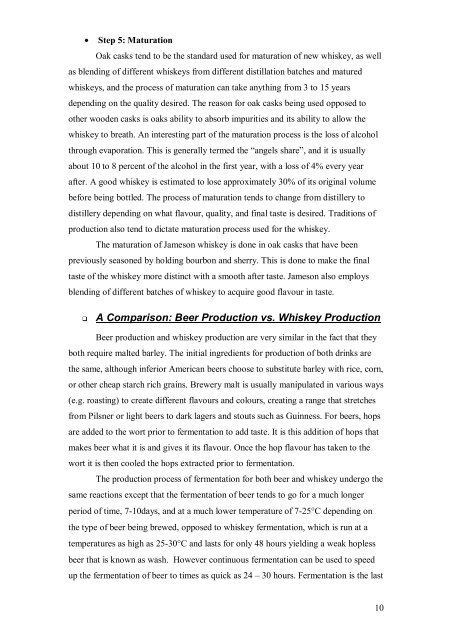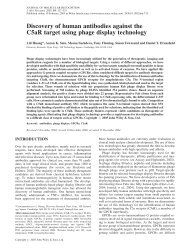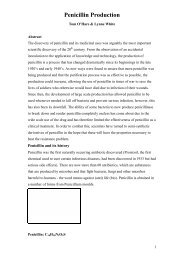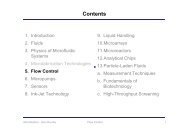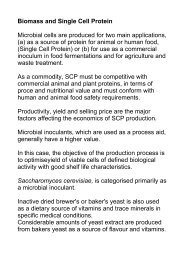BE406 Whiskey Production: A Comparison With Beer Production
BE406 Whiskey Production: A Comparison With Beer Production
BE406 Whiskey Production: A Comparison With Beer Production
Create successful ePaper yourself
Turn your PDF publications into a flip-book with our unique Google optimized e-Paper software.
• Step 5: Maturation<br />
Oak casks tend to be the standard used for maturation of new whiskey, as well<br />
as blending of different whiskeys from different distillation batches and matured<br />
whiskeys, and the process of maturation can take anything from 3 to 15 years<br />
depending on the quality desired. The reason for oak casks being used opposed to<br />
other wooden casks is oaks ability to absorb impurities and its ability to allow the<br />
whiskey to breath. An interesting part of the maturation process is the loss of alcohol<br />
through evaporation. This is generally termed the “angels share”, and it is usually<br />
about 10 to 8 percent of the alcohol in the first year, with a loss of 4% every year<br />
after. A good whiskey is estimated to lose approximately 30% of its original volume<br />
before being bottled. The process of maturation tends to change from distillery to<br />
distillery depending on what flavour, quality, and final taste is desired. Traditions of<br />
production also tend to dictate maturation process used for the whiskey.<br />
The maturation of Jameson whiskey is done in oak casks that have been<br />
previously seasoned by holding bourbon and sherry. This is done to make the final<br />
taste of the whiskey more distinct with a smooth after taste. Jameson also employs<br />
blending of different batches of whiskey to acquire good flavour in taste.<br />
� A <strong>Comparison</strong>: <strong>Beer</strong> <strong>Production</strong> vs. <strong>Whiskey</strong> <strong>Production</strong><br />
<strong>Beer</strong> production and whiskey production are very similar in the fact that they<br />
both require malted barley. The initial ingredients for production of both drinks are<br />
the same, although inferior American beers choose to substitute barley with rice, corn,<br />
or other cheap starch rich grains. Brewery malt is usually manipulated in various ways<br />
(e.g. roasting) to create different flavours and colours, creating a range that stretches<br />
from Pilsner or light beers to dark lagers and stouts such as Guinness. For beers, hops<br />
are added to the wort prior to fermentation to add taste. It is this addition of hops that<br />
makes beer what it is and gives it its flavour. Once the hop flavour has taken to the<br />
wort it is then cooled the hops extracted prior to fermentation.<br />
The production process of fermentation for both beer and whiskey undergo the<br />
same reactions except that the fermentation of beer tends to go for a much longer<br />
period of time, 7-10days, and at a much lower temperature of 7-25°C depending on<br />
the type of beer being brewed, opposed to whiskey fermentation, which is run at a<br />
temperatures as high as 25-30°C and lasts for only 48 hours yielding a weak hopless<br />
beer that is known as wash. However continuous fermentation can be used to speed<br />
up the fermentation of beer to times as quick as 24 – 30 hours. Fermentation is the last<br />
10


